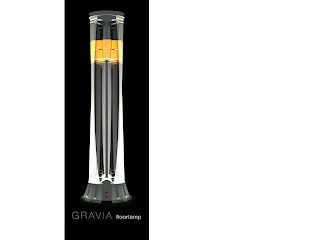Green Technology Good. Actually Works Optional.
 I think most people underestimate how much energy it really takes to power things. A quick trip to your local science and technology museum / centre should quickly dispel any misconceptions. These places usually have a stationary bicycle connected to a generator and you are encouraged to peddle to try and light a lamp or two. It doesn't take much peddling to realize that it takes a whole lot of work to light a lamp.
I think most people underestimate how much energy it really takes to power things. A quick trip to your local science and technology museum / centre should quickly dispel any misconceptions. These places usually have a stationary bicycle connected to a generator and you are encouraged to peddle to try and light a lamp or two. It doesn't take much peddling to realize that it takes a whole lot of work to light a lamp.This realization did not occur to the inventor of an environmentally friendly lamp dubbed the Gravia or to the judges judging it.
The idea is that the energy from a slowly descending weight is converted to electricity and used to power high efficiency LEDs, providing approximately 600-800 lumens of light over a 4 hour period. At the end of 4 hours, you just flip the lamp over and the whole process begins anew.
It sounds great ... except the energy output seems a little out of whack - especially if you have ever energetically peddled one of those stationary bikes in a science centre. (I also have a dynamo powered flashlight and have a feel for how much effort is needed to keep the light reasonably bright - though, nowhere near bright enough to light a room.)
A 40W light bulb gives off between 400-500 lumens of light (the amount depends on the bulb - long life bulbs give fewer lumens because they are not run as brightly) and a 60W light bulb between 600 and 800 lumens.
The total power available from the system (assuming a perfect system with no losses) is 270 Watts. Period.
This is enough to light a 40W bulb for 6-3/4 seconds or a 60W bulb for 4-1/2 seconds.
A high powered LED (420 lumens @ 8W) would burn through the power in 33-3/4 seconds.
Assuming we had device that converted 100% of the energy into light, at 600 lumens output, we would still burn through the energy in 5 minutes and 7 seconds. At 800 lumens, we would use up the energy in 3 minutes and 51 seconds
None of those remotely approach the promised 4 hour running time. If the energy were delivered over a 4 hour period, the device would be capable of a continuous output of 18.75 mW. Good enough to run an LCD watch or clock or calculator, but not much else.
Using our mythical 100% energy to light converter, we get an output of 12.8 lumens at that power level. Which is pretty dim. Dimmer than a nightlight.
As the website says for its judging criteria:
Entries were evaluated on the following criteria: innovation, clarity of design, originality, form and presentation. Being even remotely plausible was not a criteria.Image nabbed from here.
We can calculate the energy available in the system (assuming a perfect system with no losses): it is a 50lb weight falling over 48 inches. Converted to metric that is 22.73Kg over 1.22m.
Force (F = ma) available from the free falling weight is 22.73Kg x 9.8m/s2 = 222 Newtons (Kg-m/s2).
The entire energy (E = Fd) available in the system is 222N x 1.22m = 270 Joules (Kg-m2/s2).
If you use up 1 Joule per second, you use 1 Watt (N-m/s2) of energy. So the whole system has a grand total of 270 Watts of power available for use.
The continuous power the device is capable of outputting per second if run over a 4 hour period: 270W / (4 x 60 * 60) = 0.01875 W/s or 18-3/4 mW per second.
The theoretical maximum lumens per watt of power is 683 lm/W.

Comments
I am sure someone is going to come along and grumble about the fact that I loosely talk about power in the main part when I should really be talking energy (Joules), but I think for the pueposes of the post being a little loose was ok.
Something can be done, but it takes a little more than just challenging the laws of physics, it would require rewriting them.
However, there is some good research occurring now on tapping into waste energy. I plan to blog on it one day. I had blogged about it earlier, but since that post, I have learned of projects actually looking into some of the ideas I had written on (I wish I could claim to have been the inspiration, but I know they were independently conceived). There is research into piezoelectric mats, building materials and clothing, I discovered a patent for extracting energy from revolving doors, and numerous other waste energy reclamation projects.